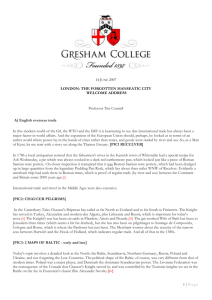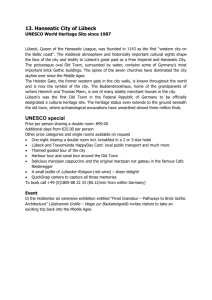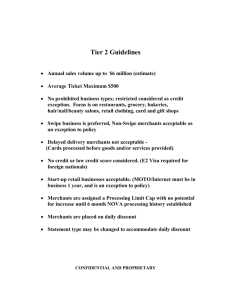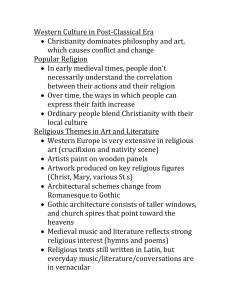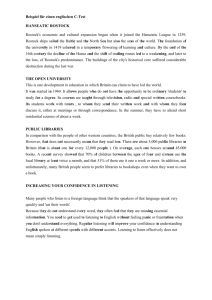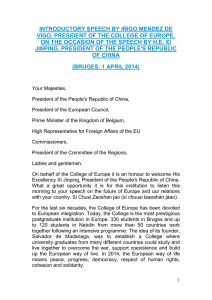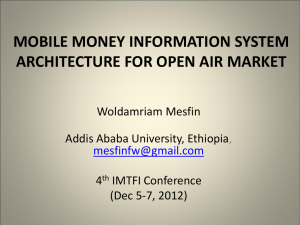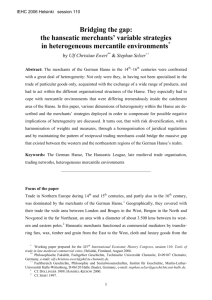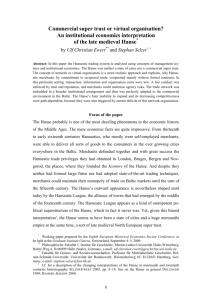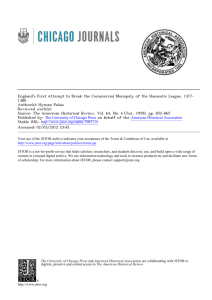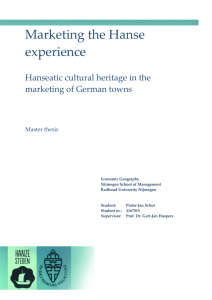why small Northern European firms survived in the late middle ages
advertisement
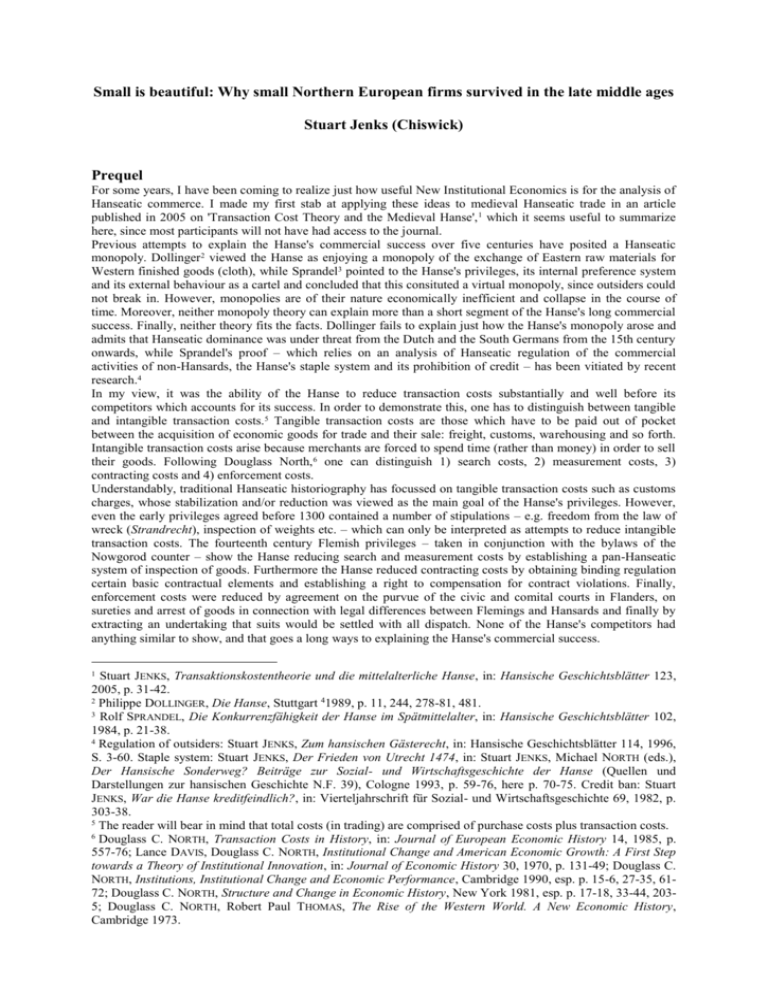
Small is beautiful: Why small Northern European firms survived in the late middle ages Stuart Jenks (Chiswick) Prequel For some years, I have been coming to realize just how useful New Institutional Economics is for the analysis of Hanseatic commerce. I made my first stab at applying these ideas to medieval Hanseatic trade in an article published in 2005 on 'Transaction Cost Theory and the Medieval Hanse', 1 which it seems useful to summarize here, since most participants will not have had access to the journal. Previous attempts to explain the Hanse's commercial success over five centuries have posited a Hanseatic monopoly. Dollinger2 viewed the Hanse as enjoying a monopoly of the exchange of Eastern raw materials for Western finished goods (cloth), while Sprandel3 pointed to the Hanse's privileges, its internal preference system and its external behaviour as a cartel and concluded that this consituted a virtual monopoly, since outsiders could not break in. However, monopolies are of their nature economically inefficient and collapse in the course of time. Moreover, neither monopoly theory can explain more than a short segment of the Hanse's long commercial success. Finally, neither theory fits the facts. Dollinger fails to explain just how the Hanse's monopoly arose and admits that Hanseatic dominance was under threat from the Dutch and the South Germans from the 15th century onwards, while Sprandel's proof – which relies on an analysis of Hanseatic regulation of the commercial activities of non-Hansards, the Hanse's staple system and its prohibition of credit – has been vitiated by recent research.4 In my view, it was the ability of the Hanse to reduce transaction costs substantially and well before its competitors which accounts for its success. In order to demonstrate this, one has to distinguish between tangible and intangible transaction costs.5 Tangible transaction costs are those which have to be paid out of pocket between the acquisition of economic goods for trade and their sale: freight, customs, warehousing and so forth. Intangible transaction costs arise because merchants are forced to spend time (rather than money) in order to sell their goods. Following Douglass North, 6 one can distinguish 1) search costs, 2) measurement costs, 3) contracting costs and 4) enforcement costs. Understandably, traditional Hanseatic historiography has focussed on tangible transaction costs such as customs charges, whose stabilization and/or reduction was viewed as the main goal of the Hanse's privileges. However, even the early privileges agreed before 1300 contained a number of stipulations – e.g. freedom from the law of wreck (Strandrecht), inspection of weights etc. – which can only be interpreted as attempts to reduce intangible transaction costs. The fourteenth century Flemish privileges – taken in conjunction with the bylaws of the Nowgorod counter – show the Hanse reducing search and measurement costs by establishing a pan-Hanseatic system of inspection of goods. Furthermore the Hanse reduced contracting costs by obtaining binding regulation certain basic contractual elements and establishing a right to compensation for contract violations. Finally, enforcement costs were reduced by agreement on the purvue of the civic and comital courts in Flanders, on sureties and arrest of goods in connection with legal differences between Flemings and Hansards and finally by extracting an undertaking that suits would be settled with all dispatch. None of the Hanse's competitors had anything similar to show, and that goes a long ways to explaining the Hanse's commercial success. 1 Stuart JENKS, Transaktionskostentheorie und die mittelalterliche Hanse, in: Hansische Geschichtsblätter 123, 2005, p. 31-42. 2 Philippe DOLLINGER, Die Hanse, Stuttgart 41989, p. 11, 244, 278-81, 481. 3 Rolf SPRANDEL, Die Konkurrenzfähigkeit der Hanse im Spätmittelalter, in: Hansische Geschichtsblätter 102, 1984, p. 21-38. 4 Regulation of outsiders: Stuart JENKS, Zum hansischen Gästerecht, in: Hansische Geschichtsblätter 114, 1996, S. 3-60. Staple system: Stuart JENKS, Der Frieden von Utrecht 1474, in: Stuart JENKS, Michael NORTH (eds.), Der Hansische Sonderweg? Beiträge zur Sozial- und Wirtschaftsgeschichte der Hanse (Quellen und Darstellungen zur hansischen Geschichte N.F. 39), Cologne 1993, p. 59-76, here p. 70-75. Credit ban: Stuart JENKS, War die Hanse kreditfeindlich?, in: Vierteljahrschrift für Sozial- und Wirtschaftsgeschichte 69, 1982, p. 303-38. 5 The reader will bear in mind that total costs (in trading) are comprised of purchase costs plus transaction costs. 6 Douglass C. NORTH, Transaction Costs in History, in: Journal of European Economic History 14, 1985, p. 557-76; Lance DAVIS, Douglass C. NORTH, Institutional Change and American Economic Growth: A First Step towards a Theory of Institutional Innovation, in: Journal of Economic History 30, 1970, p. 131-49; Douglass C. NORTH, Institutions, Institutional Change and Economic Performance, Cambridge 1990, esp. p. 15-6, 27-35, 6172; Douglass C. NORTH, Structure and Change in Economic History, New York 1981, esp. p. 17-18, 33-44, 2035; Douglass C. NORTH, Robert Paul THOMAS, The Rise of the Western World. A New Economic History, Cambridge 1973. Small is beautiful Antwerp, 7-8 December 2007 2 Some thirty years ago, Wolfgang von Stromer launched a savage philippic against the medieval Hanse.7 Compared to their counterparts in Northern Italy and Southern Germany, Hanseatic merchants were simply not up to the mark. Not only did Hanseatic towns lack technologically demanding forms of production like metallurgy, metal-working and precision engineering, they also failed to pursue policies designed to promote innovation and finance research and development. Advanced systems of production like the putting-out system were all but unknown, not to mention large companies with enormous capital resources and modern, quasi-capitalist organisational forms like cartels and world-wide monopolies. Worse yet, the Hanseatic world had no banks, nor indeed anything resembling a sophisticated financial system. Hanseatic bookkeeping was primitive and Hanseatic merchants were infinitely slow to master advanced finance techniques like foreign exchange arbitrage. In short, the Hanse was backward in almost every way. While one might well take issue with the teleological bent of von Stromer's philippic, it is indisputable that his case has not been answered. Indeed, it raises a critical question, which the master himself carefully avoided: Why did the Hansards survive? After all, as Kedar has masterfully shown,8 the collapse of the pax Mongolica around 1350 subjected Italian commerce to intense pressures, shaving profit margins to the bone and forcing the Italians to rationalize all aspects of business in order to turn a profit in the intensely competitive environment of the inner zone. Moreover, as the experience of our days shows, inefficiently run businesses will be gobbled up by their leaner and meaner competitors as surely as the Red Sox will die in July. Nevertheless, the Hansards not only survived, but prospered. In this paper I am going to sketch out a preliminary answer to the question of why this was so, despite the fact that Hanseatic merchants had none of the tools von Stromer considered essential for survival in the late middle ages. The place to start is, I think, with the nature of the firm.9 Hanseatic firms were, from the outset, small and transitory partnerships. They consisted of a socius tractans and a socius dormans, who pooled a modest amount of capital - typically 100 or 200 marks - in a 1:1 or 1:2 ratio, dividing the profits equally when the partnership was liquidated a few years later. These Hanseatic partnerships were obviously a far cry from South German companies like the Große Ravensburger Gesellschaft,10 which counted some 70 to 80 members, had a capital stock in excess of 100,000 florins and lasted from 1380 to 1530. But there was another, perhaps more significant difference: In the Hanseatic North, there was no objection to a merchant's entering multiple partnerships. Hermann Mornewech, for instance, was a sleeping partner in a total of 22 partnerships in early 14th century Lübeck. Around 1400, Hanseatic partnerships began to evolve in response to the emergence of the sedentary merchant. First of all, one central, medium-term partnership began to take priority over a host of secondary short-term partnerships. Moreover, the distinction between the socius tractans and the socius dormans gradually disappeared, as each partner sent merchandise to 7 This is the gist of Wolfgang von Stromer's article Der innovatorische Rückstand der hansischen Wirtschaft, in: Knut SCHULZ, Hg., Beiträge zur Wirtschafts- und Sozialgeschichte des Mittelalters. Festschrift für Herbert Helbig zum 65. Geburtstag, Köln/Wien 1976, p. 204-17. von Stromer's counter-argument, namely that Hanseatic historians have been wrong to focus on sea-borne trade and should have been looking at production of goods inland (notably in Brunswick) and the large firms to be found in Thorn/Toruń (Falbrecht, Moser & Co.), is frankly unconvincing. 8 Benjamin Z. KEDAR, Merchants in Crisis: Genoese and Venetian Men of Affairs and the Fourteenth-Century Depression, New Haven 1976. 9 For a masterful survey of the development of the Hanseatic firm (from which this discussion is taken) see Albrecht Cordes, Spätmittelalterlicher Gesellschaftshandel im Hanseraum (Quellen und Darstellungen zur Hansischen Geschichte NF 45), Cologne 1998. 10 On the Große Ravensburger Gesellschaft see LexMA s.v. Ravensburger Handelsgesellschaft (short, but punchy and with ample bibliography). Small is beautiful Antwerp, 7-8 December 2007 3 the other, who in turn sold it and sent goods back. Finally, merchants' bookkeeping reflected this hierarchical structure, with separate accounts being maintained for each partnership. Now, even this brief survey will have made it obvious that Hanseatic firms were incapable of performing the tasks which von Stromer thought essential for business success in the late middle ages. Their capital stock was utterly inadequate for long-term investment in innovative technology and production facilities. Moreover, partners were autonomous in their trading activity. Since they were not obliged to report on their activities or obey orders from headquarters, exchange arbitrage,11 which depended upon having a large, stable network of branches with surpluses which could be drawn upon and remitted around the world as headquarters directed, was simply beyond them. Finally, since no one partnership spanned the entire Hanseatic trading sphere, advanced bookkeeping techniques were irrelevant as an instrument of management, aside from the fact that their introduction would have involved huge start-up costs which could only have been recovered gradually. That is not to say that this structure was without redeeming merits. First of all, investing one's capital in a number of small partnerships helped to spread risk. Moreover, Hanseatic partnerships were flexible and allowed merchants to take advantage of sudden opportunities. Finally, they were appropriate for maritime commerce. Indeed, one can see how Hanseatic partnerships evolved to reflect the bi-lateral form Hanseatic trade took in the late middle ages. Fig. 1: Firms of Hans Selhorst (Reval, 1507-10) (Source: Carsten Jahnke, unpublished paper) However, Hanseatic partnerships were utterly incapable of performing two crucial functions: gathering information from the entire commercial world and making business decisions on the basis of the big picture. Notoriously, South German and Italian firms solved this problem by corresponding unceasingly with their factors and issuing orders based upon their answers. The question is: did Hanseatic partnerships find another way to solve the problem, and if so, how? Let's look at a specific example.12 In the autumn of 1399, the Bruges magistrate prohibited book transfers for bills of exchange and required payment in specie both for bills originating in Bruges and payable elsewhere and bills drawn on Bruges and payable there. The consequences were catastrophic: Overnight, the écu appreciated by 6% and exchange rates remained extremely volatile, varying by more than 1% in a single day. While those able 11 On this, see Raymond DE ROOVER, The Bruges Money Market around 1400, with a statistical supplement by Hyman SARDY (Verhandelingen van de Koninklijke Vlaamse Academie voor Wetenschappen, Letteren en Schone Kunsten van België, Klasse der Letteren, Jg. 30, Nr. 63), Brussels 1968 and Wolfgang VON STROMER, Oberdeutsche Hochfinanz 1350-1450 (VSWG Beiheift 55-7), 3 vols., Wiesbaden 1970. 12 On this crisis see DE ROOVER, Bruges Money Market. On the Hanseatic response see Stuart JENKS, War die Hanse kreditfeindlich?, in: Vierteljahrschrift für Sozial- und Wirtschaftsgeschichte 69, 1982, pp. 305-38. Small is beautiful Antwerp, 7-8 December 2007 4 to pay cash could get good bargains, commodity trading rapidly proved to be less profitable than foreign exchange speculation. Further measures passed by the magistrate in the vain hope of forcing gold out of merchants' coffers only made matters worse, until the ordinances were cancelled as of 1 October 1401. Fig. 2: The movement of the écu against the Aragonese and English currencies in the crisis of 1399 (Source for statistics: DE ROOVER, Bruges Money Market). The months are divided into thirds (1-9, 10-19, 20-end), more or less reflecting the rhythm of Italian commercial correspondence Now, as de Roover showed, the Datini correspondents in Bruges instantly came up with a way to make money out of the situation, advising their counterparts in Barcelona to remit to Bruges but not to draw on it. This reflected received wisdom in Italian business circles: Never draw on a place where money was scarce and interest rates high, and never remit to a place where money was plentiful and interest rates low. Nor were the Datini correspondents the only clever ones: By November 1399, the Catalans had gotten out of commodity trading altogether and were making a killing playing the foreign exchange market. The Hanseatic response to the crisis was, on the surface, quite different. 13 The Bruges counter sent a messenger to Lübeck almost instantly, but the Hanseatic diet responded in February 1400 that the 'matter of the Lombards' was not of great concern and had been adjourned pending discussion in the several town councils. The following November the Bruges counter again wrote to Lübeck, saying that since credit operations were producing huge losses, the diet should consider a ban. In early December, Lübeck put the counter's case to the Prussian towns and asked them to write back. As no response was forthcoming, Lübeck wrote again in late April 1401, noting that in the meantime the Nowgorod counter had seconded the Bruges counter's arguments and added that longer term loans produced the highest losses. Finally, in July 1401, the diet acceded to the Bruges counter's requests and passed a ban on credit operations in Flanders effective as of Michaelmas. As luck would have it, the ban came into effect two days before the ordinances which had caused the whole ruckus 13 This paragraph summarizes a more lengthy discussion in my War die Hanse kreditfeindlich? which includes references to the relevant sources. Small is beautiful Antwerp, 7-8 December 2007 5 were abrogated. The ban, now superfluous, was only rescinded on 14 May 1402, at the behest of the Bruges counter, which had been agitating for change since February. To those familiar with Hanseatic history, this sorry tale seems typical. The diet was glacially slow to react to the crisis, and when it did get around to doing so, its instinct was to pass heavy-handed legislation restricting merchants' freedom of action. At first glance, then, the quick-witted and free-market oriented Italians seem to have stolen a march on their dull, plodding and conservative Hanseatic competitors, who furthermore were hindered by the heavy hand of the state. In fact, however, this impression would be misleading, since a closer analysis shows that the Hansards had actually been rather clever. Hanseatic trade with Flanders around 1400 fundamentally consisted of the exchange of raw materials for Flemish cloth, while the balance of trade was chronically negative. This meant that – as cloth was sold over the winter – merchants built up funds in the East which they needed to transfer to Bruges. This was achieved by a symbiosis with West European crusaders travelling to Prussia.14 Since travelling by land was dangerous, crusaders tended to take along no more money than was needed for the journey and to borrow whatever else was required in Prussia. While the Teutonic Order advanced the funds in the first instance, it insisted that crusaders find Prussian merchants willing to undertake repaying the Order's loans in Prussia. In order to give the Order an actionable claim against the merchants, and the merchants against the crusaders – on whose behalf they had undertaken to pay the Order –, two instruments of debt were drawn up, one requiring the crusaders to pay the merchants in Bruges in late June and the other requiring the merchants to pay the Order at Christmas. In effect, the merchants were using the crusaders to transfer their idle surplusses back to Bruges, with the added fillip that they had the use of the crusaders' money in the interim. That, in turn, allowed the merchants to purchase cloth on long-term credit in Flanders, repaying their suppliers from the funds credited to them by the crusaders through the good offices of hostellers and money changers in Bruges. 14 This summarizes the arguments put forward by Werner PARAVICINI, Die Preußenreisen des europäischen Adels (Beihefte zur Francia 17/1-2), Sigmaringen 1989, 1995. Unfortunately, Paravicini has not yet published the third volume of his work, which was to be an edition of the sources on which the first two volumes were based. However, since he numbers the sources in his tables in the first two volumes, one can piece things together. I have also used Jim Murray's Bruges, Cradle of Capitalism, 1280-1390, Cambridge/England 2005 heavily. Small is beautiful Antwerp, 7-8 December 2007 6 Fig. 3: Financial dealings of West European crusaders with Prussian merchants In substance, this cycle amounted to a very long-term – and correspondingly risky – letter of exchange. Since in order to avoid the canonical prohibition of usury the merchants' debt instruments were denominated in Prussian silver, while the crusaders' debt instruments were denominated in gold coins current in Bruges, the Prussians were betting that the gold equivalent of the silver loaned to crusaders in November would suffice, once exchanged for groats in Bruges in late June, to cover their obligations to the drapers. Even if they charged substantial interest rates – and 20-30% per annum was normal – there was a risk that exchange rates would change substantially in the meantime. That, of course, is precisely what happened when the Bruges magistrate issued its ordinance in 1399: the écu went through the roof and remained volatile. Consequently, there was a real danger that Prussian merchants would receive less purchasing power in Bruges than they had contracted to repay in Prussia and would be unable to cover their loans to Flemish drapers without huge losses. If we plot the Hanseatic reaction to the crisis in Bruges against the movement of the écu in relation to the currencies in which the crusaders' loans were denominated (fig. 4), we will see just how clever the Hanse was. The counter knew exactly what was going on in the autumn of 1399, since the Hansards had the latest exchange rates from their hostellers and squawked at precisely the moment the écu began to appreciate massively against sterling and the franc. Moreover, both the counter and the diet knew what effect the Bruges ordinances would have. This explains why Lübeck was so anxious to get the opinion of the Prussian towns in early December 1400, since that was precisely when loans would have extended to crusaders there. In addition, the Diet's counter-measures were entirely appropriate: Not only would long-term credit operations have produced disastrous losses, but those prepared to pay cash for merchandise could get good bargains. Finally, the counter began to agitate for lifting the ban on credit operations at the first point after the abrogation of the Bruges ordinances when Hanseatic merchants would have been moving out into the Flemish countryside to buy cloth. Fig. 4: Exchange rates of the French and English currencies against the écu during the crisis of 1399-1402 and Hanseatic counter-measures Small is beautiful Antwerp, 7-8 December 2007 7 Let us draw some conclusions. The Hanse knew how to gather information and make the appropriate decisions. However, because we have tended to view the diet as the legislative branch of a Hanseatic government whose existence was posited rather than proved,15 it was only natural to view the ban on credit as a heavy-handed government measure. By contrast, the directives the Datini correspondents issued have been interpreted as free-market measures, although they were no less imperious in tone. However, as we have seen, Hanseatic merchants, the Bruges counter and the diet worked together to master the crisis of 1399 in a manner consonant with the structure of Hanseatic firms and trade. This successful cooperation demonstrates just how impossible it is to understand the medieval Hanse by viewing its merchants in isolation. In 1399, the Hanseatic merchant was ably flanked by his counter and the diet, which (as we have seen) gathered information on a world-wide scale and gave directions based on the big picture. In the Hanseatic world, the counter and the diet performed two crucial functions for the individual merchant – information-gathering and decisionmaking – which South German and Italian firms did in-house by correspondence with factors. The fact that the Hansards achieved the same end by cooperating with one another ad hoc, rather than erecting large, centralized, bureaucratic corporations like the Italians does not make them backward. After all, the size of the firm – as Coase showed 70 years ago16 – is merely a function of the relative cost advantage of out-sourcing and conglomeration for a given state of technology, communications and managerial science. Hence, von Stromer's unquestioning faith that 'bigger is always better' distracted him from the crucial question, namely: What cost advantages not available to Italian and South German companies enabled Hanseatic firms to remain so small? One only has to pose the question in order to see the answer: Hanseatic merchants were in a position to make major savings on the organisational costs which bore heavily on their Italian and South German competitors, who had to pay their factors salaries and spend significant amounts of money in order to correspond with them continuously. The Hansards, by contrast, were able to keep the costs of information-gathering low, since they only collected information when necessary and did so on a cooperative basis. One can also observe generally that information-gathering proceeded in concentric circles. Depending on the seriousness of the problem, merchants consulted with one another first within the counter itself, and then in regional diets (notably in the IJssel and Lower Rhine region, Prussia and Saxony) and finally during the Hanseatic diet itself. The system worked because everyone involved realized that solving the problem for which crucially important information was being gathered was in the common interest. In closing, I would like to ask just how much of this applies to the English. The question is germane, because English and Hanseatic commercial partnerships were remarkably similar in size, duration and flexibility, as Postan showed in 1957.17 However, we must recognize at the outset that our knowledge of English merchants' deliberations is very limited until the 15 This malign tendency goes back to the very founding of the Hanseatic History Association (Hansischer Geschichtsverein) in 1871 and the debates which accompanied it. It was Georg Waitz who set the tone for the future development of Hanseatic history by insisting that it be viewed as part of the 'nation's' history rather than as the sum of the local histories of the member towns. Consequently, the Hanseatic diet 'had' to be a precursor of the national legislature of the 19th century and the Hanse itself a 'major power' in the Northern Seas. It took 50 years before Fritz Rörig even broached the subject of how Hanseatic merchants conducted their business, and even in the standard monograph (Philippe DOLLINGER, Die Hanse, Stuttgart 61998), the discussion of governance and diplomacy is kept completely separate from the discussion of Hanseatic trade (which forms the middle third of the book). 16 R.H. COASE, The Nature of the Firm, in: Economica 4, 1937, pp. 386-405. 17 M.M. POSTAN, Partnership in English Medieval Commerce, in: Studi in onore di Armando Sapori, 2 vols., Milan 1957, vol. 1, pp. 519-49. See also James MASSCHAELE, The trials of partnership in medieval England: a case history, 1304, in: Edwin de WINDT (ed.), The Salt of Common Life: Individuality and Choice in the Medieval Town, Countryside and Church. Essays Presented to J. Ambrose Raftis (Studies in Medieval Culture 36), Kalamazoo 1995, pp. 157-180 for a case study. Small is beautiful Antwerp, 7-8 December 2007 8 Mercers' Acts of Court begin in 1453.18 Nonetheless, Jim Murray has made a persuasive case that English merchants came together as a trading community in Bruges from the mid-14th century, coalescing around their hostels, which specialized in providing lodging and commercial services for one nationality of merchants, with whom the hosteller had long-term contact. Indeed, we know that English merchants had founded a formal organization in Danzig by 1405 at the latest,19 with elected officers, by-laws and a meeting house. We can glean the gist of their deliberations from their correspondence with king and council and, ultimately, parliament.20 Surely, also, the City of London hosted a number of mercantile councils, as overseas traders came together first within the confines of their mysteries and then of the Merchants Adventurers21 to discuss matters of mutual concern. Unquestionably, too, the Commons' petitions in parliament on mercantile matters were only the visible tip of an iceberg of consultations which remain hidden from view. In short, it looks to me as though the English solution to the problem of information-gathering and decision-making was broadly similar to the Hanseatic one. If this turns out to have been true for Flanders also – and I have reason to hope it will –,22 then we may have the beginning of an explanation of why the great forward thrust of modern capitalism in the 17th century occurred in England and Holland and not in Italy or South Germany, where von Stromer would have led us to expect it. 18 Laetitia LYELL and Frank D. WATNEY (eds.), Acts of Court of the Mercers' Company, 1453-1527, Cambridge 1936. 19 Stuart JENKS, Die Ordnung für die englische Handelskolonie in Danzig (23. Mai 1405), in: Bernhart J ÄHNIG and Peter LETKEMANN (eds.), Danzig in acht Jahrhunderten. Beiträge zur Geschichte eines hansischen und preußischen Mittelpunktes (Quellen und Darstellungen zur Geschichte Westpreußens 23), Münster 1985, pp. 105-20. 20 Stuart JENKS, England, die Hanse und Preußen: Handel und Diplomatie, 1377-1474 (Quellen und Darstellungen zur Hansischen Geschichte NF 38), 3 vols., Cologne 1992, vol. 2. 21 My views are summarized in Stuart JENKS, England und die kontinentalen Messen im 15. Jahrhundert und die Entstehung der Merchant Adventurers, in: Peter JOHANEK, Heinz STOOB (eds.), Europäische Messen und Märktesysteme im Mittelalter und Neuzeit (Städteforschung A/39), Köln/Weimar/Wien 1996, pp. 57-86. 22 This expectation is based on a reading of some of Peter Stabel's articles, notably Marketing cloth in the Low Countries: manufacturers, brokers and merchants (14th-16th centuries), in: Peter Stabel et al. (eds.), International Trade in the Low Countries (14th-16th Centuries): Merchants, Organisation, Infrastructure. Proceedings of the International Conference, Ghent-Antwerp, 12th-13th January 1997 (Studies in Urban Social, Economic and Political History of the Medieval and Early Modern Low Countries 10), Leuven 2000, pp. 15-36.
